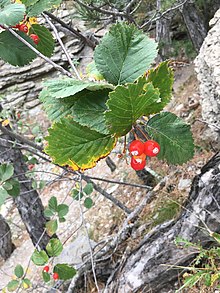Aria graeca, also known as the Greek whitebeam and fan-leaved service-tree, is a species of whitebeam, in the rose family (Rosaceae).[2][3][4][5]
| Aria graeca | |
|---|---|

| |
| Balkan whitebeam leaves and flowers | |
| Scientific classification | |
| Kingdom: | Plantae |
| Clade: | Tracheophytes |
| Clade: | Angiosperms |
| Clade: | Eudicots |
| Clade: | Rosids |
| Order: | Rosales |
| Family: | Rosaceae |
| Genus: | Aria |
| Species: | A. graeca
|
| Binomial name | |
| Aria graeca (Lodd. ex Spach) M.Roem.
| |
| Synonyms[1] | |
|
List
| |
Description edit
The Greek whitebeam is a deciduous shrub or small tree from 1 to 8 metres high. It is superficially similar to the closely related common whitebeam, but differs in having more strongly pronounced serrations on its leaves. It bears white flowers and red pomes.[5][6]
Distribution and habitat edit
The tree is native to central and southeastern Europe (Albania, Austria, the Balearics, Bosnia-Herzegovina, Bulgaria, Croatia, Czech Republic, France, Germany, Greece, Hungary, Italy, Malta, Poland, Romania, Sicily, Slovakia, Slovenia, Serbia, Turkey, Ukraine), the Caucasus (Armenia, Azerbaijan, Georgia), the Eastern Mediterranean (Cyprus, Lebanon, Syria) and parts of North Africa (Algeria, Morocco).[7]
References edit
- ^ "Aria graeca (Lodd. ex Spach) M.Roem. | Plants of the World Online | Kew Science". Plants of the World Online. Retrieved 2023-09-12.
- ^ "Sorbus graeca Lodd. ex Schauer — The Plant List". www.theplantlist.org. Retrieved 2016-12-30.
- ^ "The Euro+Med Plantbase Project". ww2.bgbm.org. Botanic Garden and Botanical Museum Berlin. 2006. Retrieved 2016-12-30.
- ^ "Sorbus graeca (SOUGC)[Overview] EPPO Global Database". gd.eppo.int. European and Mediterranean Plant Protection Organization. Retrieved 2016-12-30.
- ^ a b "Lebanon FLORA". www.lebanon-flora.org (in French). Université Saint Joseph, Beyrouth. Retrieved 2016-12-30.
- ^ "Hortipedia - Sorbus graeca". en.hortipedia.com. Retrieved 2023-06-30.
- ^ "Distribution". ww2.bgbm.org. Botanic Garden and Botanical Museum Berlin. 2006. Retrieved 2016-12-30.